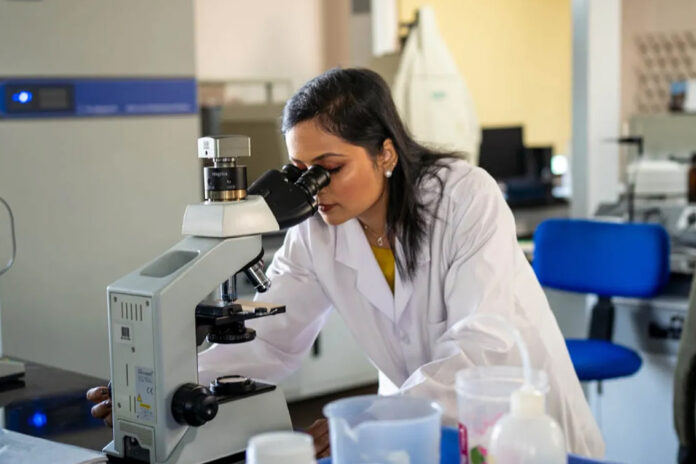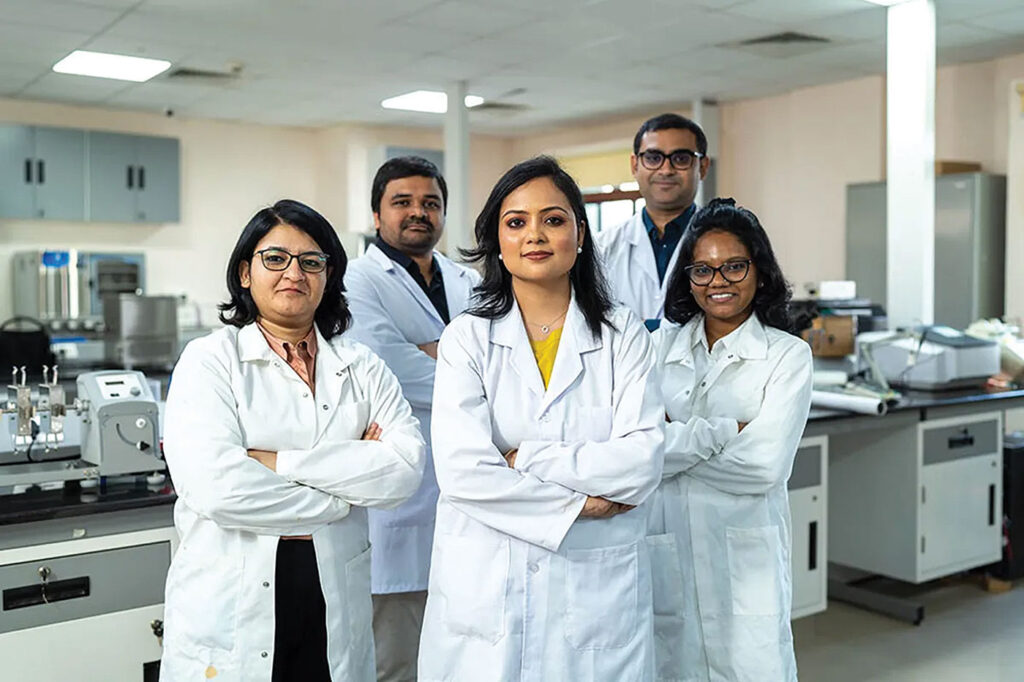
At the beginning of April, Vertex Pharmaceuticals and CRISPR Therapeutics announced they had applied for FDA approval for Exa-cel for treatment of sickle cell disease and beta thalassemia. If approved, this will be the first ever therapeutic approval for a gene edited therapy.
With a number of similar gene editing therapies in development, safety and avoidance of off-target effects is an important consideration. This was one of the founding principles of Helex, a U.S.- and India-based biotech using artificial intelligence (AI) and machine learning (ML) and a 3D epigenome-based approach to make gene edited therapies that are safe and effective.
Inside Precision Medicine senior editor Helen Albert spoke with Poulami Chaudhuri, PhD, the CEO and co-founder of Helex, about founding an international start-up during a pandemic, being a female biotech founder in India, the importance of looking at DNA in 3D when designing therapies, and the future of the company.
Q: How did you get into science?

Poulami Chaudhuri: I think during my A levels the enlightenment happened. There was a very interesting chapter [in one of my textbooks] on transgenic crops. That basically made me feel that using science, I could really be a kind of magician. That is what made me take genetics at university.
I pursued my master’s degree at King’s College London in molecular biology. The real hands-on science that I got to do there made me feel sure that I definitely want to do a PhD, which I did at Kings as well.
Afterwards, I met a researcher who was extremely good with computational biology and decided to do a postdoc with him. I realized during that time that it’s not just about doing molecular biology, or doing wet lab science and inventing something—we need to accelerate the process. That is when I learned about the importance of intelligent platforms. Instead of the brute force trial-and-error methodology of doing science, you really need to leverage [artificial intelligence] and [machine learning] tools to make your life much easier, and I could see how my PhD [research] could have been transformed if I had had that background.
Q: What inspired you to found Helex?
PC: The whole journey of entrepreneurship was very different for me. When I was pregnant with my baby, as a geneticist with a background of molecular biology, I was always concerned [about] whether he was going to be okay. I went through all possible tests and screening to ensure that he was fine and when he was born, and he was all right, I was relieved. At the same time, I thought about all those mothers who go through this. What if he had a disorder? Is there a cure? Is it accessible?
I realized that I really had the potential to do something about this because of my background. I learned how to do molecular biology, I knew how to manipulate genes, and I knew how amazing this gene editing technology is. If I could make a difference in terms of accelerating the development of gene editing therapies and enabling their true potential, then I thought I would be serving my purpose. And that is how I started Helex.
Q: What are you trying to achieve at Helex?
PC: There are about 185 gene editing-based therapies, which are currently stuck at various levels of regulatory approval. There are two problems that are hindering the translation of gene editing–based therapies to the market. One is precision and the other is safety, and at Helex we’re trying to solve these two key challenges.
When we talk about precision, there’s so much innovation that’s happening around the delivery vectors, but there’s always a chance that the delivery vector gets distributed in unintended places. For example, when you’re trying to solve a liver disease, if it gets into [the] lung, editing there can have serious consequences. It’s a very grey area. That has really been a setback for translation, because regulatory approval is not easy when there’s uncertainty.
At Helex, we take a three-dimensional point of view to understand and introduce precision into the gene editing or drug design that we do. So if you’re making a therapy for the liver, we consider the genomics and the 3D architecture [of the stretch of DNA to be edited]. If you know that the delivery vector would actually get into the lung, we do competitive analysis and ensure that the [DNA] hotspot that has been selected for developing the therapies is uniquely accessible in the liver and not in the lungs. That way, even if there is leaky biodistribution by the vector, our drug design acts as a second lock and prevents the editing from happening in the off-target tissues.
Q: What was the process of founding the company like?
PC: It’s been a very, very exciting journey. My co-founders and I have known each other for 15 years. We went to King’s College together during our master’s and we were flatmates. Afterwards, we went on to do different things. Anirudh Nishtala, my husband, chief operating officer and co-founder, went on to do business development for a pharma company and then he went on to do healthcare management. Rohini Kalvakuntla, our chief growth officer and other co-founder, was from a very different background; she was doing business administration, but she was, again, using those skills for the healthcare industry. We always kept in touch, and then we realised that we wanted to do something new. We all had very comfortable jobs before we started doing this, but we wanted to do something that was groundbreaking, we also wanted to do it in the space of healthcare and to make an impact.
We started Helex in 2021, when my son was six months old. It wasn’t easy because of the pandemic, but I have a very supportive family. Anirudh, being my husband, doesn’t help because we’re always working like crazy, but my parents [and] my husband’s father are amazing. Without them, I wouldn’t have been able to do what I do today. People always used to say that you need a community to raise a child. A startup is exactly like that. You cannot do it on your own. You need support, not just at work, but in your personal life as well.
Q: How easy has it been to get investors on board?
PC: We recently closed our pre-seed round, and we raised about $3 million. It’s been quite a good journey so far. We got selected by IndieBio, one of the biggest biotech accelerators in the U.S. They supported and believed in us, and then we got SOSV on board, because they saw our progress when we graduated. I think IndieBio has really helped us in terms of networking, which wouldn’t have been possible to do on our own in the beginning.
Now, of course, we are more familiar with the market, we know people, we are better with our networking skills. We are getting to meet a lot of investors and the interest is there, because it’s becoming more and more evident that you need a lot more perspective in terms of developing the therapeutics. Epigenetics is known. Gene editing is also known, but nobody tried to combine these two to look at it from the perspective of enhancing precision or safety, and that is what we do.
Q: What are your future plans for the company?
PC: We want to complete our seed round, and I also want to do at least some projects with bigger biopharma. We’re already talking to quite a few companies.
Other than that, we are collecting preclinical data. Right now, we are working on a particular retinal dystrophy called Stargardt disease. The platform applies to this disease very well.
When you do a subretinal injection, it’s a very localised delivery, so it will go to the right eye cells, but there’s a very big risk that it also goes to the neuronal cells, such as the retinal ganglion cells. The ganglion cells have some critical genes which are in open configuration, because they are constantly expressed. If your editing apparatus gets into the wrong cells and cuts one of these important genes, the consequences are going to be huge.
Leveraging our technology, you’re able to solve both precision as well as safety. Once this whole thing is developed, it will be very easy for us to scale up in terms of any other retinal disorder. Meanwhile, we also want to start working on a second indication.… We’re still figuring out which one we will be working on, but there are multiple targets in mind.
Q: Why did you decide to found the company in the U.S. and not India?
PC: For CRISPR, the market in the U.S. is ready. There’s a huge genetic burden in India, but the market isn’t ready for it yet. Nobody [in India] understands what I’m doing right now. In the U.S., everybody’s speaking the language, they understand what’s happening, there are therapies being developed and clinical trials. We understood that what we are building is actually for that market to start with.
We were pitching to different accelerators, and all the accelerators actually were in the U.S. or in the U.K.—there were so many of them. With IndieBio, we actually evolved as a company with them. It was not a single conversation, it was multiple conversations that ultimately led to our selection, and they were extremely open minded, because at that time it was just a concept, but what they believed in was the team.

We realized that we three actually have the skills that can make a company, that can make a successful product. [The accelerators] saw that in us. I still remember when we were getting selected and they said, ‘we don’t know what you’re going to make. But we are sure that whatever you make is going to work.’ They believed in us.
Q: What management lessons have you learnt since starting the company?
PC: I thought doing a PhD was tough, but this seems like I’m doing four PhDs in parallel! You really need to be strategic if you want to grow and you want to grow fast, especially in the kind of field that we are in where everything is changing every day.
I think the main management lesson that I have learned is to trust people. It’s very easy to think ‘I’ll do it all by myself,’ or ‘what if the person screws up?’ But you’ll never progress that way, and I’m still learning that.
I have a team and I have a call with them every day in the morning. I ask them to solve the problems. I’m not in the lab looking over their shoulders. The same goes for the rest of the company in terms of operations or business development. I totally trust my co-founders to make decisions which are in their field.
Selecting the team is crucial. You need to identify who fits in and who’s not made for a startup, which was very difficult for me initially—I was in that mentoring role all the time. As much as you might want to mentor, you also have to understand if a person is made for a startup or not.
Q: Are you involved in any mentoring programs?
PC: Yes, I take interns every year. These are undergraduate or master’s students. I give them exposure to what it is like to be working for a startup, and I give them very serious work. I make them do something new that adds value to the company.
I try to make sure that they are mostly women, because I really want to inspire them. I think it’s so important. If you look at the Indian ecosystem, you will hardly find any Indian women entrepreneurs.… Nobody has done it, so the path seems very uncertain. But I think the grit and determination that women have means they absolutely can do it. I’ve been through the worst. And I’ve seen that I can still make it.
Q: What advice would you give yourself if you could go back to day one of Helex?
PC: When you are working on an idea, it seems like this is your life. I think it’s very important to understand that this is not your life. You are passionate about it, excellent, but this is also a job and you need to learn how to switch off. If you can’t, you’ll be just burnt out and overwhelmed.
I’ve gone through that phase. But I’ve learned to manage myself better, because life moves on. Your professional life and your personal life both need to go hand in hand. I think the advice I would give is ‘don’t be so harsh on yourself.’
You can’t make all the deadlines, or all the networking events. You can’t be doing your best all the time. It’s important to set realistic targets for yourself and understand that you do need to live as well!
Helen Albert is senior editor at Inside Precision Medicine and a freelance science journalist. Prior to going freelance, she was editor-in-chief at Labiotech, an English-language, digital publication based in Berlin focusing on the European biotech industry. Before moving to Germany, she worked at a range of different science and health-focused publications in London. She was editor of The Biochemist magazine and blog, but also worked as a senior reporter at Springer Nature’s medwireNews for a number of years, as well as freelancing for various international publications. She has written for New Scientist, Chemistry World, Biodesigned, The BMJ, Forbes, Science Business, Cosmos magazine, and GEN. Helen has academic degrees in genetics and anthropology, and also spent some time early in her career working at the Sanger Institute in Cambridge before deciding to move into journalism.












